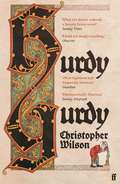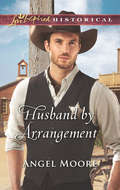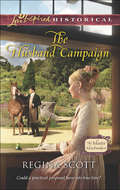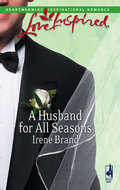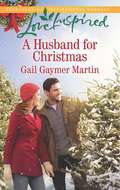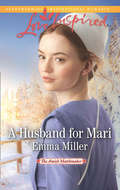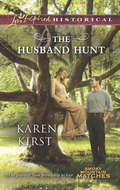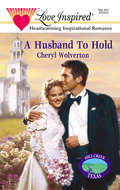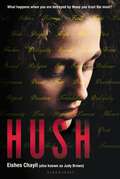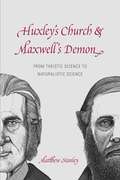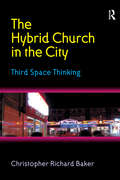- Table View
- List View
Hunted: Predation and Pentecostalism in Guatemala (Class 200: New Studies in Religion)
by Kevin Lewis O'Neill“It’s not a process,” one pastor insisted, “rehabilitation is a miracle.” In the face of addiction and few state resources, Pentecostal pastors in Guatemala City are fighting what they understand to be a major crisis. Yet the treatment centers they operate produce this miracle of rehabilitation through extraordinary means: captivity. These men of faith snatch drug users off the streets, often at the request of family members, and then lock them up inside their centers for months, sometimes years. Hunted is based on more than ten years of fieldwork among these centers and the drug users that populate them. Over time, as Kevin Lewis O’Neill engaged both those in treatment and those who surveilled them, he grew increasingly concerned that he, too, had become a hunter, albeit one snatching up information. This thoughtful, intense book will reframe the arc of redemption we so often associate with drug rehabilitation, painting instead a seemingly endless cycle of hunt, capture, and release.
Hunted: Predation and Pentecostalism in Guatemala (Class 200: New Studies in Religion)
by Kevin Lewis O'Neill“It’s not a process,” one pastor insisted, “rehabilitation is a miracle.” In the face of addiction and few state resources, Pentecostal pastors in Guatemala City are fighting what they understand to be a major crisis. Yet the treatment centers they operate produce this miracle of rehabilitation through extraordinary means: captivity. These men of faith snatch drug users off the streets, often at the request of family members, and then lock them up inside their centers for months, sometimes years. Hunted is based on more than ten years of fieldwork among these centers and the drug users that populate them. Over time, as Kevin Lewis O’Neill engaged both those in treatment and those who surveilled them, he grew increasingly concerned that he, too, had become a hunter, albeit one snatching up information. This thoughtful, intense book will reframe the arc of redemption we so often associate with drug rehabilitation, painting instead a seemingly endless cycle of hunt, capture, and release.
Hunter's Bride and A Mother's Wish: Hunter's Bride / A Mother's Wish (Mills And Boon Love Inspired Ser.)
by Marta PerryHunter's Bride Due to a little misunderstanding spinning out of control, Chloe Caldwell's family now thinks her boss, Luke Hunter, is her fiancé. Luckily, the handsome executive is willing to play the part for reasons of his own. He never dreamed a woman, a family and the faith he left long ago would change everything….
Hunting Hope: Dig Through the Darkness to Find the Light
by Nika MaplesWhen you can't see any hope in a season of difficulty, hunt for it by holding onto God's character and letting Him develop your own.
Hurdy Gurdy: 'This comic tale will rescue you from lockdown misery.' The Times
by Christopher WilsonI pledge on the jeopardy of my immortal soul. I saw it all, with my young eyes. From start to end.And may Lucifer, and his infernal demons, fry my liver for break-fast if a word of this sorry history turns out to be a lie.It is the year of our Lord 1349 and it is the season of the Plague. Novice friar Brother Diggory, now sixteen, has lived in the Monastery of the Order of St Odo at Whye since his eighth birthday. But his life is about to change. The sickness is creeping ever closer and the monks must attend to the victims. When Brother Diggory is nominated to tend to those afflicted, he realises he is about to meet the Plague, and that it is more powerful than him. What he doesn't realise is that encountering an illness and understanding it are two quite different things.An uproarious and uplifting novel about sickness and health, the fashions of 14th Century medicine, and how perhaps we're never quite as cutting-edge as we might like to believe.
Hurt Sentiments: Secularism and Belonging in South Asia
by Neeti NairAn insightful history of censorship, hate speech, and majoritarianism in post-partition South Asia.At the time of the India-Pakistan partition in 1947, it was widely expected that India would be secular, home to members of different religious traditions and communities, whereas Pakistan would be a homeland for Muslims and an Islamic state. Seventy-five years later, India is on the precipice of declaring itself a Hindu state, and Pakistan has drawn ever narrower interpretations of what it means to be an Islamic republic. Bangladesh, the former eastern wing of Pakistan, has swung between professing secularism and Islam.Neeti Nair assesses landmark debates since partition—debates over the constitutional status of religious minorities and the meanings of secularism and Islam that have evolved to meet the demands of populist electoral majorities. She crosses political and territorial boundaries to bring together cases of censorship in India, Pakistan, and Bangladesh, each involving claims of “hurt sentiments” on the part of individuals and religious communities. Such cases, while debated in the subcontinent’s courts and parliaments, are increasingly decided on its streets in acts of vigilantism.Hurt Sentiments offers historical context to illuminate how claims of hurt religious sentiments have been weaponized by majorities. Disputes over hate speech and censorship, Nair argues, have materially influenced questions of minority representation and belonging that partition was supposed to have resolved. Meanwhile, growing legal recognition and political solicitation of religious sentiments have fueled a secular resistance.
The Hurtle of Hell: An atheist comedy featuring God and a confused young man from Hackney (G - Reference, Information And Interdisciplinary Subjects Ser.)
by Simon EdgeAn atheist comedy featuring God and a confused young man from Hackney. When gay, pleasure-seeking Stefano Cartwright is almost killed by a wave while at the beach, his journey up a tunnel of light convinces him that God exists after all, and he may need to change his ways if he is not to end up in hell. When God happens to look down his celestial telescope and see Stefano, he is obliged to pay unprecedented attention to an obscure planet in a distant galaxy, and ends up on the greatest adventure of his multi-eon existence.The Hurtle of Hell combines a tender, human story of rejection and reconnection with an utterly original and often very funny theological thought-experiment, in an entrancing fable that is both mischievous and big-hearted.
Husband By Arrangement: Frontier Matchmaker Bride The Amish Nanny's Sweetheart Accidental Family Husband By Arrangement (Mills And Boon Love Inspired Historical Ser.)
by Angel MooreSuddenly a Family
The Husband Campaign: The Courting Campaign The Wife Campaign The Husband Campaign (The Master Matchmakers #3)
by Regina ScottA Marriage of Necessity
A Husband for All Seasons
by Irene BrandHis faith was being tested for the first time: Chad Reece's promising pro football career was cut short by a devastating accident, and then a kidney transplant revealed his biological parents were a couple he'd considered family friends.
A Husband For Christmas: A Reunion For The Rancher A Husband For Christmas A Texas Christmas Wish (Mills And Boon Love Inspired Ser. #1)
by Gail Gaymer MartinSpending her holidays in picturesque Lilac Circle, Michigan, is the perfect place for Nina Jerome to start anew. She's determined to put her painful divorce in the past and focus on the future. She hadn't planned on being distracted by her sweet neighbor, Doug Billings.
The Husband Hunt: The Husband Hunt The Duke's Marriage Mission Wolf Creek Wedding Finally A Bride (Smoky Mountain Matches #4)
by Karen KirstWANTED: A HUSBAND. Sophie Tanner gave up hoping for Nathan O’Malley’s approval—and love—long ago. Getting married is the only way to protect her younger brother and keep her family’s Smoky Mountain farm. As much as she’d like Nathan to be the groom, he can't seem to get past their friendship…
A Husband To Hold (Mills And Boon Love Inspired Ser. #No. 136)
by Cheryl WolvertonRUNNING AWAY She had caught everyone's eye. Petite, mysterious Leah Thomas was new to Hill Creek, Texas, and the entire town had taken notice. Especially one handsome cowboy, who'd offered to give Leah some much-needed help.
Hush
by Eishes ChayilInside the closed community of Borough Park, where most Chassidim live, the rules of life are very clear, determined by an ancient script written thousands of years before down to the last detail-and abuse has never been a part of it. But when thirteen-year-old Gittel learns of the abuse her best friend has suffered at the hands of her own family member, the adults in her community try to persuade Gittel, and themselves, that nothing happened. Forced to remain silent, Gittel begins to question everything she was raised to believe.A richly detailed and nuanced book, one of both humor and depth, understanding and horror, this story explains a complex world that remains an echo of its past, and illuminates the conflict between yesterday's traditions and today's reality.
The Hutterites in North America (Young Center Books in Anabaptist and Pietist Studies)
by Rod Janzen Max StantonOne of the longest-lived communal societies in North America, the Hutterites have developed multifaceted communitarian perspectives on everything from conflict resolution and decision-making practices to standards of living and care for the elderly. This compellingly written book offers a glimpse into the complex and varied lives of the nearly 500 North American Hutterite communities.North American Hutterites today number around 50,000 and have common roots with and beliefs akin to the Amish and other Old Order Christians. This historical analysis and anthropological investigation draws on existing research, primary sources, and over 25 years of the authors' interaction with Hutterite communities to recount the group's physical and spiritual journey from its 16th-century founding in Eastern Europe and its near disappearance in Transylvania in the 1760s to its late 19th-century transplantation to North America and into the modern era. It explains how the Hutterites found creative ways to manage social and economic changes over more than five centuries while holding to the principles and cultural values embedded in their faith.Religious scholars, anthropologists, and historians of America and the Anabaptist faiths will find this objective-yet-appreciative account of the Hutterites' distinct North American culture to be a valuable and fascinating study both of the religion and of a viable alternative to modern-day capitalism.
Huxley's Church and Maxwell's Demon: From Theistic Science to Naturalistic Science
by Matthew StanleyDuring the Victorian period, the practice of science shifted from a religious context to a naturalistic one. It is generally assumed that this shift occurred because naturalistic science was distinct from and superior to theistic science. Yet as Huxley’s Church and Maxwell’s Demon reveals, most of the methodological values underlying scientific practice were virtually identical for the theists and the naturalists: each agreed on the importance of the uniformity of natural laws, the use of hypothesis and theory, the moral value of science, and intellectual freedom. But if scientific naturalism did not rise to dominance because of its methodological superiority, then how did it triumph? Matthew Stanley explores the overlap and shift between theistic and naturalistic science through a parallel study of two major scientific figures: James Clerk Maxwell, a devout Christian physicist, and Thomas Henry Huxley, the iconoclast biologist who coined the word agnostic. Both were deeply engaged in the methodological, institutional, and political issues that were crucial to the theistic-naturalistic transformation. What Stanley’s analysis of these figures reveals is that the scientific naturalists executed a number of strategies over a generation to gain control of the institutions of scientific education and to reimagine the history of their discipline. Rather than a sudden revolution, the similarity between theistic and naturalistic science allowed for a relatively smooth transition in practice from the old guard to the new.
Huxley's Church and Maxwell's Demon: From Theistic Science to Naturalistic Science
by Matthew StanleyDuring the Victorian period, the practice of science shifted from a religious context to a naturalistic one. It is generally assumed that this shift occurred because naturalistic science was distinct from and superior to theistic science. Yet as Huxley’s Church and Maxwell’s Demon reveals, most of the methodological values underlying scientific practice were virtually identical for the theists and the naturalists: each agreed on the importance of the uniformity of natural laws, the use of hypothesis and theory, the moral value of science, and intellectual freedom. But if scientific naturalism did not rise to dominance because of its methodological superiority, then how did it triumph? Matthew Stanley explores the overlap and shift between theistic and naturalistic science through a parallel study of two major scientific figures: James Clerk Maxwell, a devout Christian physicist, and Thomas Henry Huxley, the iconoclast biologist who coined the word agnostic. Both were deeply engaged in the methodological, institutional, and political issues that were crucial to the theistic-naturalistic transformation. What Stanley’s analysis of these figures reveals is that the scientific naturalists executed a number of strategies over a generation to gain control of the institutions of scientific education and to reimagine the history of their discipline. Rather than a sudden revolution, the similarity between theistic and naturalistic science allowed for a relatively smooth transition in practice from the old guard to the new.
Huxley's Church and Maxwell's Demon: From Theistic Science to Naturalistic Science
by Matthew StanleyDuring the Victorian period, the practice of science shifted from a religious context to a naturalistic one. It is generally assumed that this shift occurred because naturalistic science was distinct from and superior to theistic science. Yet as Huxley’s Church and Maxwell’s Demon reveals, most of the methodological values underlying scientific practice were virtually identical for the theists and the naturalists: each agreed on the importance of the uniformity of natural laws, the use of hypothesis and theory, the moral value of science, and intellectual freedom. But if scientific naturalism did not rise to dominance because of its methodological superiority, then how did it triumph? Matthew Stanley explores the overlap and shift between theistic and naturalistic science through a parallel study of two major scientific figures: James Clerk Maxwell, a devout Christian physicist, and Thomas Henry Huxley, the iconoclast biologist who coined the word agnostic. Both were deeply engaged in the methodological, institutional, and political issues that were crucial to the theistic-naturalistic transformation. What Stanley’s analysis of these figures reveals is that the scientific naturalists executed a number of strategies over a generation to gain control of the institutions of scientific education and to reimagine the history of their discipline. Rather than a sudden revolution, the similarity between theistic and naturalistic science allowed for a relatively smooth transition in practice from the old guard to the new.
Huxley's Church and Maxwell's Demon: From Theistic Science to Naturalistic Science
by Matthew StanleyDuring the Victorian period, the practice of science shifted from a religious context to a naturalistic one. It is generally assumed that this shift occurred because naturalistic science was distinct from and superior to theistic science. Yet as Huxley’s Church and Maxwell’s Demon reveals, most of the methodological values underlying scientific practice were virtually identical for the theists and the naturalists: each agreed on the importance of the uniformity of natural laws, the use of hypothesis and theory, the moral value of science, and intellectual freedom. But if scientific naturalism did not rise to dominance because of its methodological superiority, then how did it triumph? Matthew Stanley explores the overlap and shift between theistic and naturalistic science through a parallel study of two major scientific figures: James Clerk Maxwell, a devout Christian physicist, and Thomas Henry Huxley, the iconoclast biologist who coined the word agnostic. Both were deeply engaged in the methodological, institutional, and political issues that were crucial to the theistic-naturalistic transformation. What Stanley’s analysis of these figures reveals is that the scientific naturalists executed a number of strategies over a generation to gain control of the institutions of scientific education and to reimagine the history of their discipline. Rather than a sudden revolution, the similarity between theistic and naturalistic science allowed for a relatively smooth transition in practice from the old guard to the new.
Huxley's Church and Maxwell's Demon: From Theistic Science to Naturalistic Science
by Matthew StanleyDuring the Victorian period, the practice of science shifted from a religious context to a naturalistic one. It is generally assumed that this shift occurred because naturalistic science was distinct from and superior to theistic science. Yet as Huxley’s Church and Maxwell’s Demon reveals, most of the methodological values underlying scientific practice were virtually identical for the theists and the naturalists: each agreed on the importance of the uniformity of natural laws, the use of hypothesis and theory, the moral value of science, and intellectual freedom. But if scientific naturalism did not rise to dominance because of its methodological superiority, then how did it triumph? Matthew Stanley explores the overlap and shift between theistic and naturalistic science through a parallel study of two major scientific figures: James Clerk Maxwell, a devout Christian physicist, and Thomas Henry Huxley, the iconoclast biologist who coined the word agnostic. Both were deeply engaged in the methodological, institutional, and political issues that were crucial to the theistic-naturalistic transformation. What Stanley’s analysis of these figures reveals is that the scientific naturalists executed a number of strategies over a generation to gain control of the institutions of scientific education and to reimagine the history of their discipline. Rather than a sudden revolution, the similarity between theistic and naturalistic science allowed for a relatively smooth transition in practice from the old guard to the new.
Huxley's Church and Maxwell's Demon: From Theistic Science to Naturalistic Science
by Matthew StanleyDuring the Victorian period, the practice of science shifted from a religious context to a naturalistic one. It is generally assumed that this shift occurred because naturalistic science was distinct from and superior to theistic science. Yet as Huxley’s Church and Maxwell’s Demon reveals, most of the methodological values underlying scientific practice were virtually identical for the theists and the naturalists: each agreed on the importance of the uniformity of natural laws, the use of hypothesis and theory, the moral value of science, and intellectual freedom. But if scientific naturalism did not rise to dominance because of its methodological superiority, then how did it triumph? Matthew Stanley explores the overlap and shift between theistic and naturalistic science through a parallel study of two major scientific figures: James Clerk Maxwell, a devout Christian physicist, and Thomas Henry Huxley, the iconoclast biologist who coined the word agnostic. Both were deeply engaged in the methodological, institutional, and political issues that were crucial to the theistic-naturalistic transformation. What Stanley’s analysis of these figures reveals is that the scientific naturalists executed a number of strategies over a generation to gain control of the institutions of scientific education and to reimagine the history of their discipline. Rather than a sudden revolution, the similarity between theistic and naturalistic science allowed for a relatively smooth transition in practice from the old guard to the new.
Hybrid Church: The Fusion of Intimacy and Impact (Jossey-Bass Leadership Network Series #51)
by Dave BrowningA hands-on resource for both large and small churches It has been predicted that in the twenty-first century extremely large churches would emerge in America that resemble neither an elephant nor a field of mice. Which is better? At one time the answer would have been either/or. Now it's both/and. We want both the intimacy of smallness and the impact of bigness-we want a hybrid of the two. Hybrid Church is a practical guide for clergy and leaders who want to have the best of both church worlds: the intimacy of small "house church" groups and the impact of very large mega-churches. Offers a guide for churches who want to capitalize on their strengths to build intimacy with impact Written by the pastor of one of the "fastest growing" and "most innovative" churches in America with thousands of members organized in small house groups Outlines a vision for how the church of tomorrow could look like the early church. Given that the trend is toward very large and very small, with few churches in the middle, this book will be a welcome resource for both large and small churches.
Hybrid Church: The Fusion of Intimacy and Impact (Jossey-Bass Leadership Network Series #51)
by Dave BrowningA hands-on resource for both large and small churches It has been predicted that in the twenty-first century extremely large churches would emerge in America that resemble neither an elephant nor a field of mice. Which is better? At one time the answer would have been either/or. Now it's both/and. We want both the intimacy of smallness and the impact of bigness-we want a hybrid of the two. Hybrid Church is a practical guide for clergy and leaders who want to have the best of both church worlds: the intimacy of small "house church" groups and the impact of very large mega-churches. Offers a guide for churches who want to capitalize on their strengths to build intimacy with impact Written by the pastor of one of the "fastest growing" and "most innovative" churches in America with thousands of members organized in small house groups Outlines a vision for how the church of tomorrow could look like the early church. Given that the trend is toward very large and very small, with few churches in the middle, this book will be a welcome resource for both large and small churches.
The Hybrid Church in the City: Third Space Thinking
by Christopher Richard BakerThe era of post-colonialism and globalisation has brought new intensities of debate concerning the existence of diversity and plurality, and the need to work in partnerships to resolve major problems of injustice and marginalisation now facing local and global communities. The Church is struggling to connect with the significant economic, political and cultural changes impacting on all types of urban context but especially city centres, inner rings and outer estates and the new ex-urban communities being developed beyond the suburbs. This book argues that theology and the church need to engage more seriously with post-modern reality and thought if points of connection (both theologically and pastorally) are going to be created. The author proposes a sustained engagement with a key concept to emerge from post-modern experience - namely the concept of the Third Space. Drawing on case studies from Europe and the USA primarily, this book examines examples of Third Space methodologies to ask questions about hybrid identities and methods churches might adopt to effectively connect with post-modern cities and civil society. Particular areas of focus by the author include: the role and identity of church in post-modern urban space; the role of public theology in addressing key issues of marginalisation and urbanisation as they impact in the 21st century; the nature and role of local civil society as a local response to globalised patterns of urban, economic, social and cultural change.



